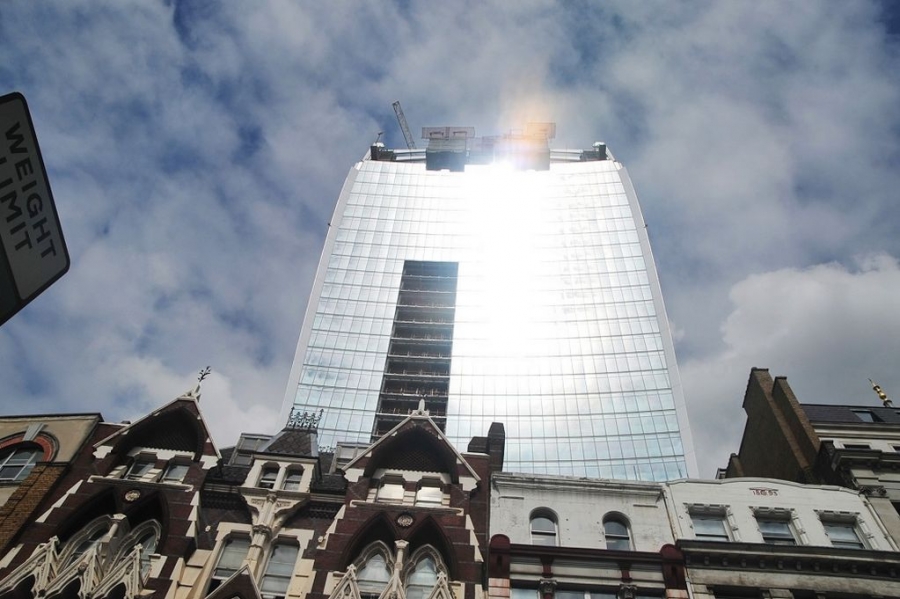Developers Submit Plan to fix Walkie Talkie Skyscraper’s Sun Ray Problems

Developer Land Securities and Canary Wharf Group submitted a plan on Wednesday to fix the “Death Ray” coming from sunlight bouncing off the Walkie Talkie building. The 160-meter, 34-story office building located at 20 Fenchurch Street in London is currently under construction. Last fall, the skyscraper briefly became a tourist destination due to the car-melting light beam cast by the tower. The beam reached temperatures as high as 110 degrees Celsius in September, and it melted parts of parked cars and even set fire to a doormat at a barbershop. Temporary scaffolding was erected across the street to prevent the sun’s rays from causing damage to nearby buildings and pedestrians, and all parking spots were fenced off so no other cars would be melted.
The building’s developers believe a brise soleil system will fix the problem. In architecture, brise soleil refers to a number of different permanent sun-shading structures. According to them, the brise soleil system would install aluminum fins on the building between floors three and 34, and it will prevent solar glare by absorbing sunlight. The Walkie Talkie building’s exterior is curved and some of the glass on the higher stories is curved down towards the street. This design traps sunrays and has a magnifying effect. Fortunately, the building only acts as a mirror for roughly two hours per day, and the “Death Ray’s” strength depends on the height of the sun in the sky. The Walkie Talkie building is not the only building to experience this phenomenon. In 2003, light reflecting off the Walt Disney Concert Hall in Los Angeles caused sidewalk temperatures to reach 60 degrees Celsius and the glare affected drivers’ vision. The building’s owners ended up having to shut down the exterior panels of the Concert Hall to reduce the glare. Many other lesser-known examples of this problem also exist.
If approved, the brise soleil system will take six months to install and cost less than $10 million. The £200 million Walkie Talkie building is currently 64 percent leased, and the developers are awaiting legal confirmation on another 23 percent. The scheduled completion date is in April. This is not the first time the building has come under scrutiny. The skyscraper was supposed to be 200 meters tall originally, but many people complained that it would obstruct the views of nearby St. Paul’s Cathedral and the Tower of London. Despite reducing the building’s height, many London residents continued to complain about the building until a 2007 public inquiry ruled in favor of the developers and the Walkie Talkie building was granted full planning permission. The building’s main feature is a rooftop garden that will be the highest public park in London once finished. People will be able to access the park by two express elevators, and they will also be able to eat at a café, bar, and restaurant with great views of London.
Sources: Sydney Morning Herald, BBC
Want to read more like this story?

27 Dead in Two India Building Collapses
Jul, 01, 2014 | NewsTwo deadly building collapses occurred in India this past weekend claiming the lives of 27 people. T...

Melbourne Approves Skinny Skyscraper
Feb, 03, 2014 | NewsThe Melbourne Minister of Planning recently approved a 73-story, 230-meter skyscraper that will be j...

London’s Tallest Skyscraper Opens to the Public
Oct, 01, 2014 | NewsLondon’s newest and tallest skyscraper opened its doors to the public last weekend after being under...

Building collapses in Italy: the second failure in few days!
Sep, 28, 2016 | NewsLast Thursday, a collapse of a four-story building occurred in the Ponte Milvio area of northern Rom...

The Winner of Building Design Magazine 2015!
Sep, 09, 2015 | NewsThe building of the Uruguayan architect Rafael Viñoly Beceiro, '20 Fenchurch Street' - that Londoner...

236 New High-Rise Buildings Planned for London’s Skyline
Mar, 14, 2014 | NewsA new study published, by the New London Architecture think tank on Wednesday, found that there are...

Lloyd’s building stands out in London: functionality and modern design
Sep, 16, 2016 | NewsAccording to “TimeOut London”, Lloyd’s building is one of the most impressive buildings in London. I...

Property owner Wanted to Save Rhode Island’s Tallest Building
Feb, 11, 2014 | NewsThe owner of Rhode Island’s tallest building renewed his effort on Monday to gain support for a publ...

A four-storey building collapsed after efforts to rectify its imbalance in South Kolkata
Jan, 15, 2025 | NewsOn Tuesday January 14 around 3:05 p.m. local time a four-storey building gave way and fell onto a o...
Trending

Spectacular interchanges around the world

New Release - STAAD.Pro 2024 - 2

ADINA 2025 for Structural WorkSuite

ADINA 2025 New Release!

Concrete Buildings as Rechargeable Batteries

Powerful earthquake shakes central Philippines, dozens killed


